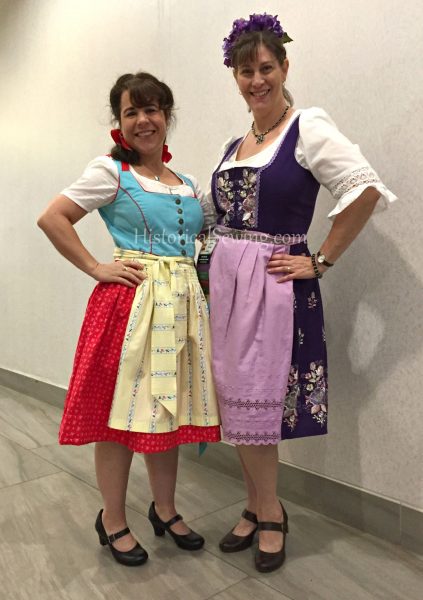
So many of you have followed me throughout the years – thank you! – and noticed when I started talking about Bavarian (Germany) and Austrian dirndls. It was just over two years ago. You can watch a Facebook Live I did in February 2018 when my excitement blossomed.
It’s so thrilling to have discovered in my research of dirndls that Victorian and 19th Century sewing techniques could be used in tandem with modern methods to create these lovely ensembles. Double yay!!
For example….
- Flatlining and underlining
- Cartridge pleating
- Piping
- Finishing edges with bias (examples here)
- Hem facings
- Natural fiber fabrics like cotton and linen
- Ribbon trims
… are all found in 19th Century dressmaking AND in dirndl making. And I’ve been teaching you these things since 2008. 😀
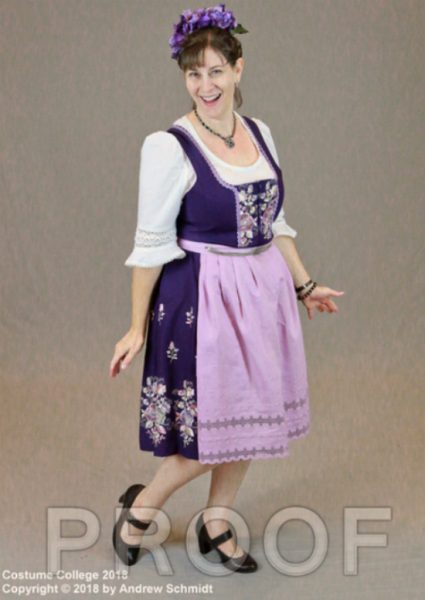
Now, after making three complete dirndl ensembles, along with altering a vintage 1980s one, I want more.
And I want to share my new-found passion with you!
Dirndls have practically taken over most of my sewing these days. I’m still sewing historical, too! Just not as often as I used to. (Being a mid-40s first time mom with a young child is challenging with only snippets of sewing time.) And believe you, me – that 1898 Valley Dress project from The Harvey Girls is still on the docket!
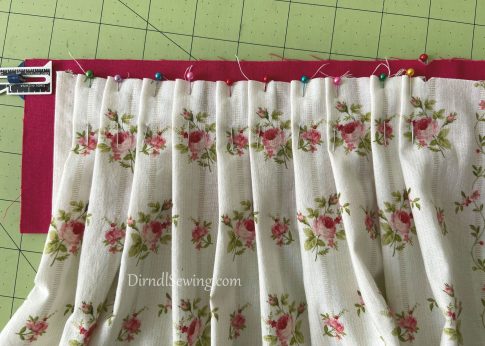
So in light of the pivot in my sewing, AND with my newest online class, a full Dirndl Sewing Workshop (coming May 2020), I’ve set up an entirely new website. (Basically it’s keeping this blog site more focused on historical teaching and projects, and for those who want to join me in this journey of dirndl sewing and wearing you’ll have a dedicated place for all the things there.)
For those who want MORE on dirndls, their history, construction, inspiration, sewing tips, and all other good things associated (including a new pattern line – whoot!), you can find me at
DirndlSewing.com – which is under my new brand name of Emma Lily Designs.
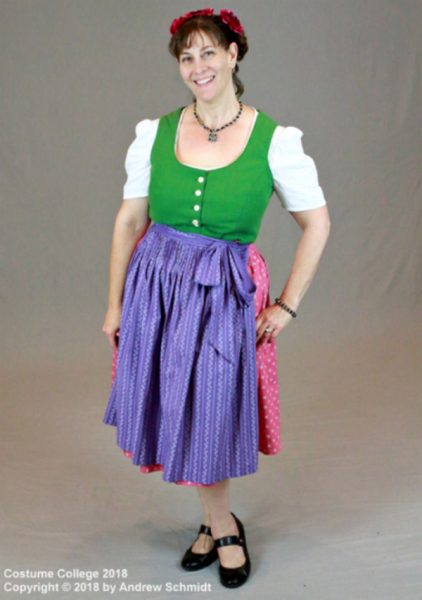
I hope you’ll join me over at the new site! A few blog posts are already up as well as is a new free guide to fabric shopping for your dirndls when you join the newsletter list. Welcome!
P.S. Because I know you’ll ask, this blog site is NOT going away! Nor are my online classes on historical projects and techniques. I’ll still post here when relevant. And will still keep the podcast going as I find time to record new episodes. 🙂
I’m so happy to have you part of our Joyful Community whether here at Historical Sewing or at Emma Lily. <3

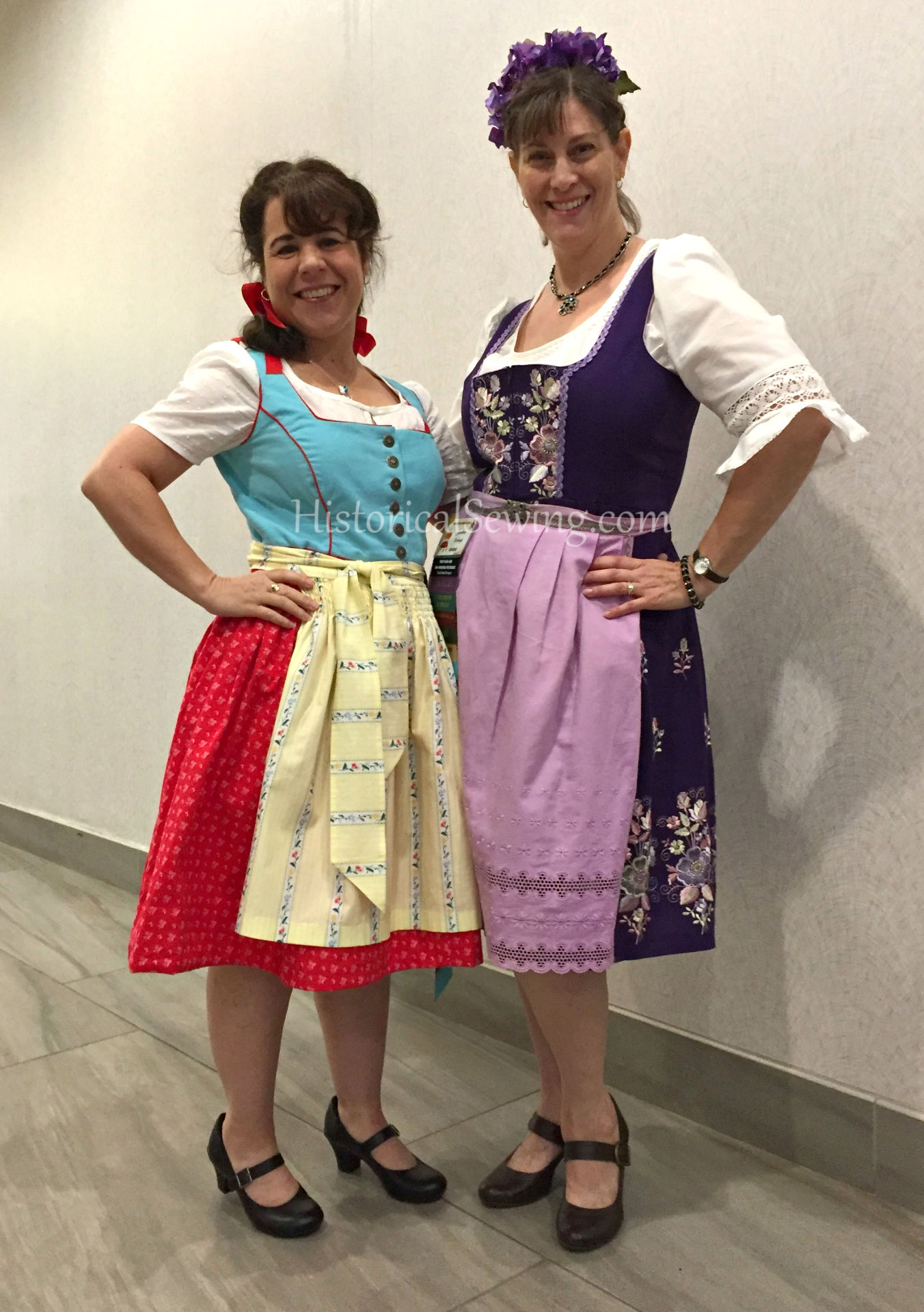
As someone from germany I am so incredible happy that you used the correct term, bavarian Dirndl or bayrische Tracht wich makes it clear that this was only worn by a part of german folks.
Due to our country being a patchwork of more or less independend states throughout history (even more so after the fall of the great emperors) germany developed an abundance of different traditions, clothing etc. We would´t even speak “our” version of german today if it weren´t for Martin Luther translating the bible. Bavarian Trachten are only the most known becaue Bavaria pretty much mashed up all their sterotypes and put it into the Oktoberfest (and then exported that stuff aggressively). But if you go north towards the sea there is a noticable change in clothing, it also has a lot to do with influences from different countries, too.
And it´s also a wonderful sight seeing such a wonderful handcrafted item, even more so because you did not shy away from colours!
Thank you for the comment! Yes, I try to be honorable to the dirndl and Tracht as I research this regional clothing. Indeed, modern dirndl fashion doesn’t cover other parts of Germany and is based directly from Bavarian styles… that, as you said, were what became the Oktoberfest fashion and highly marketed to tourists.
It´s nice seeing someone actally putting in some research (wich is to be ecpected from a website like this of course!)
And I really hope that you will make another Tracht form a diffenent Part of my country someday. Even though they have similatities, the all have a very unique look 🙂
Do you know where I can find information on the tracht from Eastern Prussia which is now part of Russia. This is the region my family come from but I can’t find any info on how the clothes were made. I’d love make one myself.
I’ve not done any research on that area. Perhaps try a general folk dress search and go from there. (Use DuckDuckGo as the search engine for more thorough results.) Sorry I don’t have any starting points for you. Best of luck!
The reason why sewing a Dirndl is so similar to historical sewing is because all German traditional clothing is based in history. I am currently researching German “Trachten” (which is the German word for historical clothing including but not limited to Dirndl). For example the “Spreewaldtracht” developed at the opposite end of Germany as the Dirndl, and yet you’ll see parralels in the skirts, bodices and aprons.
As always in history, the poorer rural population was several decades late with adopting the newest fashion trends and the more extreme trends weren’t adopted for reasons of practicality. Then sometime during the industrial revolution the rich urban population started romanticizing the simple farm life and rural people. Their oldfashioned clothing of that time (“Tracht” means literally “the clothing which is worn”) suddenly became A Thing Frozen in Time and in the following decades it developed in parralel to current fashion. Bodices were boned less strongly, the number of underskirts decreased and the pleats in petticoats got wider and reduced in number, but in the end, even a modern Dirndl is just a historical dress adapted to current fashion.
By the way, a similar developent can be seen in the Scottish Kilt. It started as just the thing people wore every day and was later romanticised and resurrected with adaptations to current fashion.
Thank you for the insight!
Greetings from Seattle, Miss Jennifer!
Are you buying imported German linen as it is different from what we get in the US? I found locally some organic hemp that has a heftier hand.
I am also looking to you for the type of lace to insert into blouses and aprons.
Email me when you have an idea.
Vielen dank fur alles!!!
Rita Harris
Hi Rita!
I HAVE used linen from Germany – from Laura und Ben – which was very nice quality. I’ve also used a basic linen/rayon blend from JoAnns that had a good hand (I purchased in store so was able to touch it). The linen from Fabrics-Store.com is good quality and I’d recommend, along with linen from Renaissance Fabrics. But I’m all for using local businesses if you’ve found some!
As for laces (and trims) – the variety is endless! Think of those one would use for Edwardian blouses. Net laces are beautiful as insertions. I used a 4″ wide cotton one (maybe from JoAnns or Beverly’s) for one of my blouses (inset around the sleeve). Embroidered and woven ribbons are wonderful for aprons. Farmhouse fabrics carries wonderful trims. Simply keep an eye out as so much that’s available can be used on dirndls. You can also browse my dirndl trim Pinterest board to give you ideas on what’s currently being used.
Prost!
Very interested in your dirndl class! I’ve been following you for years and my fascination with folk dress is a big part of what got me into historical dress.
I just had a baby though, and will likely be breastfeeding for at least the next few years. Have you come across any ways to make them nursing friendly?
I’d love to make myself a few if I can nurse in them
I have seen a few maternity dirndls. I will say, the front button (or zip) closure plus a blouse with a single button or wrap front could very easily be worn my nursing mothers.
will be signing up as soon as the month cycles! (too much month at the end of my budget as always)
How much is the dirndl class Jennifer?
The enrollment fee has not yet been decided on, but you can find more info about the workshop here.
Nice Dirndl! I like Austrian clothing and German clothing.
Jennifer, I like your Dirndl because, it has some rich fabrics that you have sewed before. And you have added a ribbon on it. Nice work!
This is so exciting. I am in a German dance group and we get to wear dirndls for performances and events – but I haven’t thought of making one! Jennifer, we met very briefly at CoCo 2019. I wish I had brought my dirndl to join the meetup! I will definitely be signing up for the workshop in the future and am looking forward to your new blog 🙂
How fun to be in a dance group! And welcome to the new dirndl sewing group. 🙂
This came at the perfect time! I literally just ordered the Folkwear dirndl pattern after hemming and hawing over it for months. I initially felt guilty in light of the current pandemic (“Should I be buying fun things when money is tighter? A pattern is a non-essential item isn’t it?”) but my friends assured me I was 1) supporting a small business, 2) supporting the USPS, and 3) “It’s essential to your mental health!”
I look forward to more dirndl goodness. 🙂
Yay!
And thank you for supporting all the things! So important to keep doing that. No guilt. 🙂